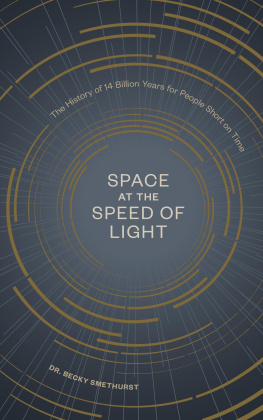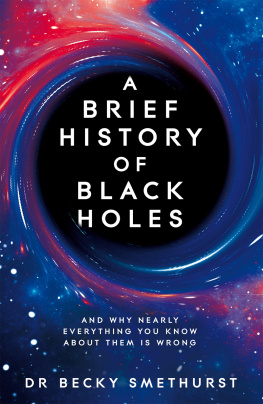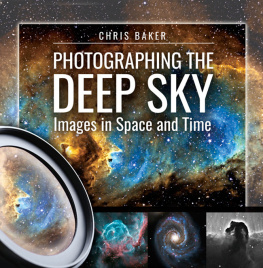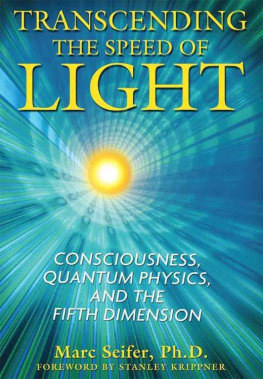Dr. Becky Smethurst - Space at the speed of light: the History of 14 Billion Years for People Short on Time
Here you can read online Dr. Becky Smethurst - Space at the speed of light: the History of 14 Billion Years for People Short on Time full text of the book (entire story) in english for free. Download pdf and epub, get meaning, cover and reviews about this ebook. year: 2020, publisher: Potter/Ten Speed/Harmony/Rodale, genre: Children. Description of the work, (preface) as well as reviews are available. Best literature library LitArk.com created for fans of good reading and offers a wide selection of genres:
Romance novel
Science fiction
Adventure
Detective
Science
History
Home and family
Prose
Art
Politics
Computer
Non-fiction
Religion
Business
Children
Humor
Choose a favorite category and find really read worthwhile books. Enjoy immersion in the world of imagination, feel the emotions of the characters or learn something new for yourself, make an fascinating discovery.
- Book:Space at the speed of light: the History of 14 Billion Years for People Short on Time
- Author:
- Publisher:Potter/Ten Speed/Harmony/Rodale
- Genre:
- Year:2020
- Rating:4 / 5
- Favourites:Add to favourites
- Your mark:
- 80
- 1
- 2
- 3
- 4
- 5
Space at the speed of light: the History of 14 Billion Years for People Short on Time: summary, description and annotation
We offer to read an annotation, description, summary or preface (depends on what the author of the book "Space at the speed of light: the History of 14 Billion Years for People Short on Time" wrote himself). If you haven't found the necessary information about the book — write in the comments, we will try to find it.
Dr. Becky Smethurst: author's other books
Who wrote Space at the speed of light: the History of 14 Billion Years for People Short on Time? Find out the surname, the name of the author of the book and a list of all author's works by series.
Space at the speed of light: the History of 14 Billion Years for People Short on Time — read online for free the complete book (whole text) full work
Below is the text of the book, divided by pages. System saving the place of the last page read, allows you to conveniently read the book "Space at the speed of light: the History of 14 Billion Years for People Short on Time" online for free, without having to search again every time where you left off. Put a bookmark, and you can go to the page where you finished reading at any time.
Font size:
Interval:
Bookmark:
Acknowledgments
Two years ago you would have heard me confidently state that I would never, in a billion years, write a book, because how in the universe did people have enough patience to sit down and write an entire book?
In part, my barrier was that I was told by my high school English teacher that I wasnt a good writeror, at least, that I write the way I talk. Turns out writing the way you talk might actually be a good thing for a popular science book. What I didnt realize is that when you write a book you get editors who help make you sound brilliant. So, to Emily, Anne, and Jennifer at Orionthank you for turning my science word vomit into something elegant and concise. And for dealing with my love affair with just , a word that previously peppered this manuscript. To Shaida, Windy, Betsy, Dan, Mary, and all those at Penguin Random House for taking on the mammoth task of getting this published in North America. Im always in awe of those who can create something out of nothing, so a big thank you to Justin for the beautiful artwork throughout this book.
I have collected all of the information in this book over many years of education from some truly wonderful people. Firstly, thank you to my thesis supervisor, Chris, and friendly neighborhood postdoc (now hotshot lecturer!) Brooke, who taught me that science is all about asking the right questions and that observations should never be left buried in desks. To my masters supervisor, Russell, who taught me that making mistakes is how we learn. To all my teachers at school, especially Mrs. Kyle, Mrs. McCann, and Mr. West, who taught me the foundations of math and physics. And, while Im here, thank you to my first grade teacher, Mrs. Dean, for taking an inquisitive (and, lets face it, annoying) child into your class and nurturing her curiosity rather than smothering it. You should all know that everything I do, I do standing on your shoulders.
Thank you to my mum, dad, and sister for teaching me to be different, to look before I leap, and to dare to dream.
And finally, to Sam, for teaching me to laugh, always .
About the Author
Dr. Becky Smethurst is an astrophysicist and research fellow at the University of Oxford. Her current research is focused on the question of how galaxies and black holes evolve together. Her weekly YouTube videos explain unsolved cosmological mysteries, weird objects found in space, and general space news. Dr. Smethurst also presents physics videos for the YouTube channel Sixty Symbols and astronomy videos for Deep Sky Videos. She was shortlisted for an Early Career Physics Communicator Award by the Institute of Physics and was named Audience Winner in the UK national finals of the FameLab competition.

The Sun is just one star in more than 100 billion stars in our galaxy, the Milky Way. Its an island of gas, dust, and stars, more than a million trillion kilometers across. At the center of the Milky Way star system theres a black hole four million times more massive than the Sun. Thats something we call a supermassive black hole, and like the Sun in our solar system, its in the gravitational driving seat of our whole galaxy.
Isaac Newton discovered the law that governs gravity some centuries ago: two objects will attract each other proportional to how heavy each object is. The lighter object will be affected more by the force between the two objects. The force also depends on how far apart the two objects are: the farther apart they are, the weaker the force between them. If you double their distance, the force drops to a quarter of its original strength. With these laws, we can work out the effect of gravity between any two objects in the universe, including between you and the Earth under your feet.
The law of gravity brings order from chaos; it is, after all, what produced our solar system. Before the Sun formed there was only a giant cloud of hydrogen and helium gas, with a sprinkling of heavier elements like oxygen, carbon, and iron, left over from a previous generation of stars. This cloud was a swirling mess containing the atoms of each element. As each atom is a tiny particle of a certain mass, they were gravitationally attracted to all the other particles in that messy gas cloud. Those particles began to clump together under gravity, with the biggest clumps attracting the other clumps, until eventually gravity overcame the energy of all the particles whizzing around and trapped them together to, effectively, cool them down. The next step was the collapse of the gas cloud down to a really high density where the pressure increased so much that it got hot enough to ignite nuclear fusion and our star was born.
Nuclear fusion is when stars, like the Sun, turn four atoms of hydrogen into one atom of helium, and its why all the stars in our night sky shine. So, what once was a swirling cloud of gas, full of atoms whizzing around, became a burning protostar because of gravity.
Now, that endlessly whirling cloud of gas will also have been harboring a remnant of the past. It will have inherited some leftover rotational energy, which we call angular momentum, from a previous generation of stars, perhaps even the first stars to form after the creation of the universe. This means that, overall, the gas cloud was swirling preferentially in a certain direction, so that as particles started to clump together under gravity, they assumed that same preference: the proto-Sun began spinning. What happened to the rest of the gas cloud around the early Sun is the same as what happens to a ball of pizza dough when you spin it above your head: it flattened out into a saucer, or a disk, which went on spinning. Inside the disk, the gravitational attraction between particles continued, so that more clumps formed into protoplanets around the Sun, giving us a beautifully ordered system where the planets (plus comets, asteroids, and other leftover bits of rock) all orbit around it in the same direction. This process is how we think all stars, not only the Sun, have formed.
The same thing is reflected in our own Earth-Moon system. The Earth spins in the same direction as it orbits because the tiny particles that clumped together to make it had inherited that hint of angular momentum from the previous generation of stars. Similarly, the Moon orbits around the Earth in the direction that the Earth spins.
But thats where the similarities stop, because the rest of the Moons properties are consistently strange. Its day is as long as its year. That means the time it takes the Moon to spin around on its axis, its day, is the same time it takes for it to orbit the Earth, its year, which is twenty-eight Earth days. If the Earth followed this example, half the planet would always be in daylight and half would always be in darkness throughout the whole year, as the Earth made one orbit around the Sun. The Earth would spin at the same rate to keep one side always facing away from the Sun. This is why we only ever see one side of the Moonwe never see its far side because it never points toward us. Thats not to say the far side is the dark side, however, because the Earth doesnt light up the Moon, the Sun does. This is why we see the phases of the Moon: We see a Full Moon when it is on the opposite side of the sky to the Sun, which then fully lights up the side of the Moon pointing toward us. And we see a New Moon when the Moon is between us and the Sun, so the Sun is lighting up the side that points away from us.
If you are now wondering why we dont get a total solar eclipse every twenty-eight days, considering the Moon passes between the Sun and the Earth on each of its orbits, the reason is because the Moon is not orbiting in the same plane that the Earth orbits around the Sun. Its slightly tilted by about five degrees. So, sometimes it passes just below, and sometimes just above, the Sun in the sky during its New Moon phase.
Font size:
Interval:
Bookmark:
Similar books «Space at the speed of light: the History of 14 Billion Years for People Short on Time»
Look at similar books to Space at the speed of light: the History of 14 Billion Years for People Short on Time. We have selected literature similar in name and meaning in the hope of providing readers with more options to find new, interesting, not yet read works.
Discussion, reviews of the book Space at the speed of light: the History of 14 Billion Years for People Short on Time and just readers' own opinions. Leave your comments, write what you think about the work, its meaning or the main characters. Specify what exactly you liked and what you didn't like, and why you think so.








